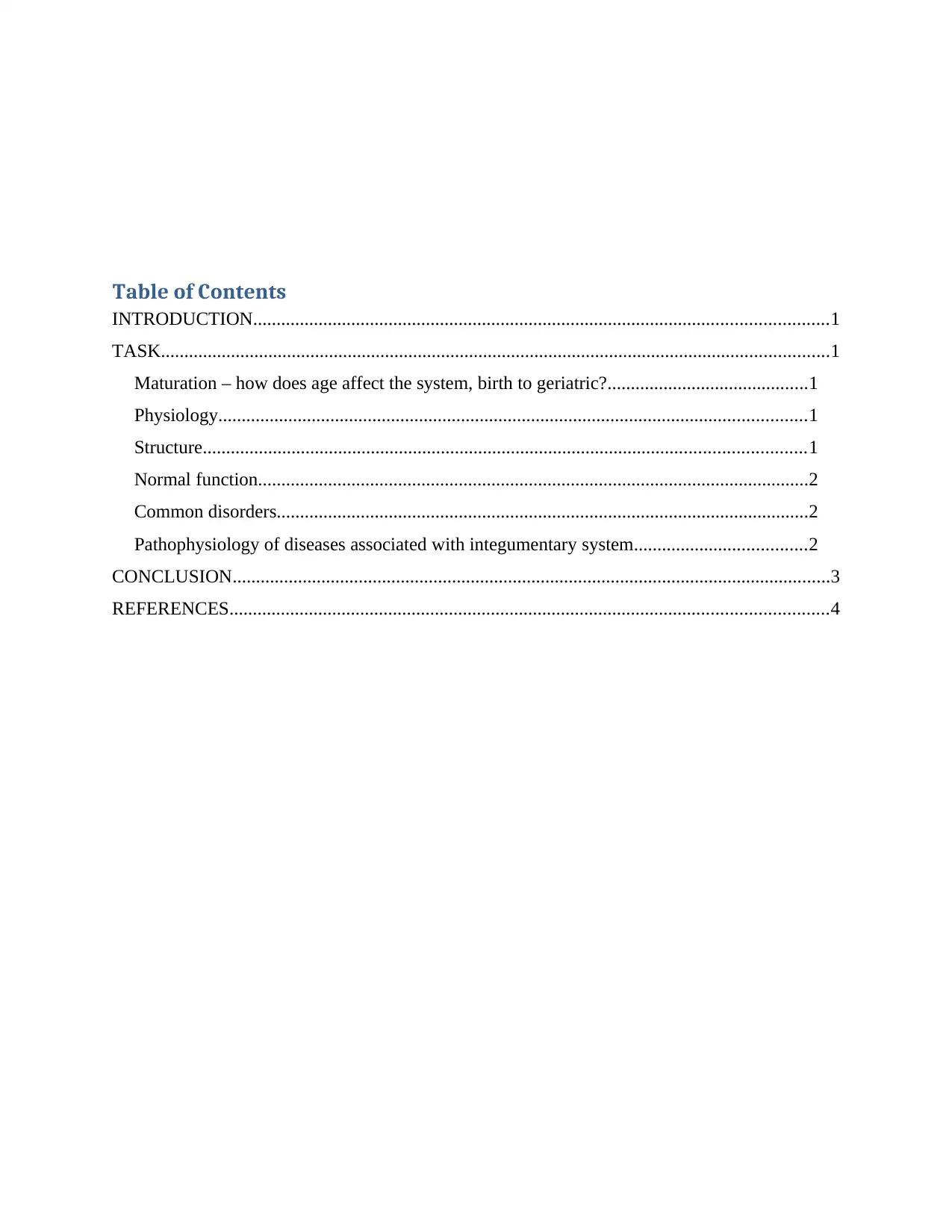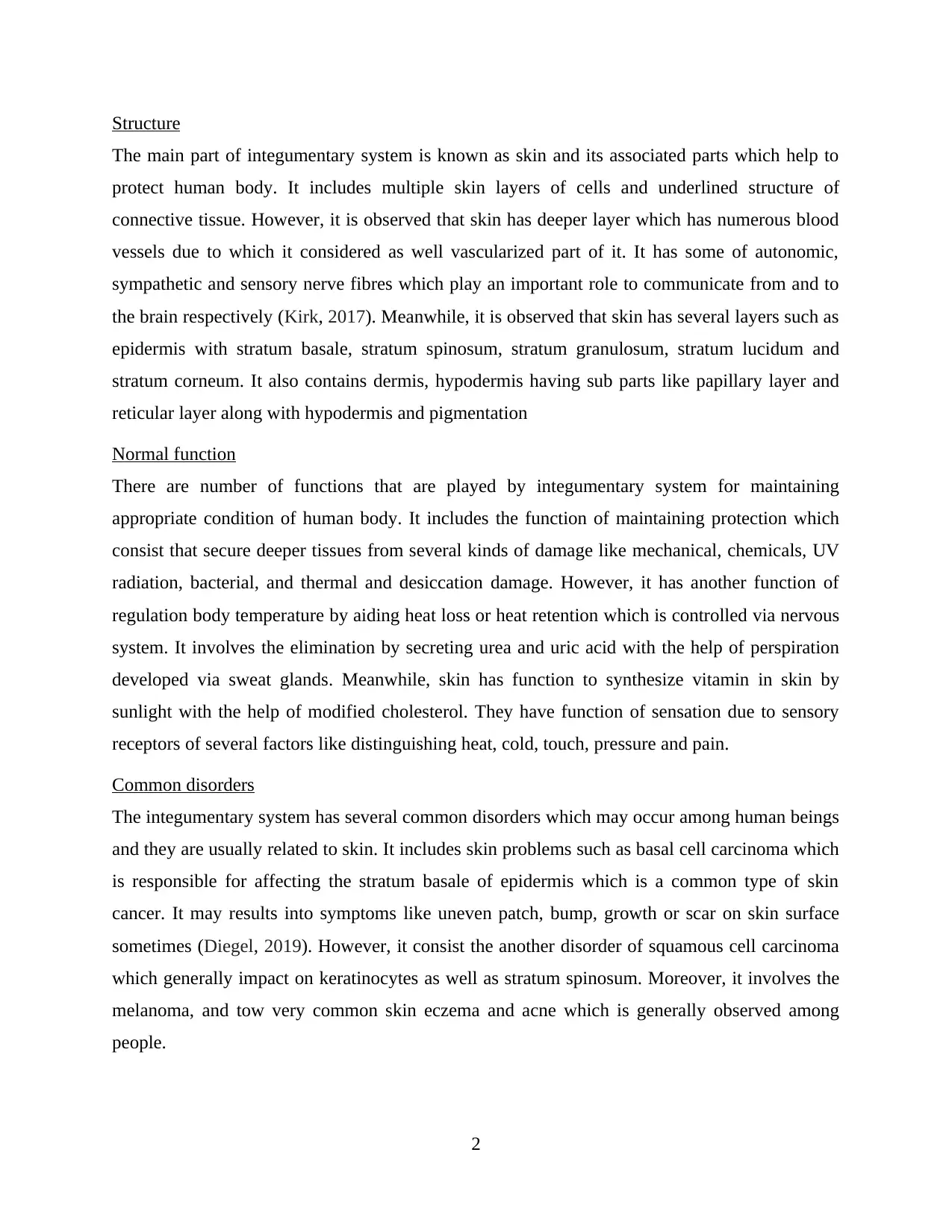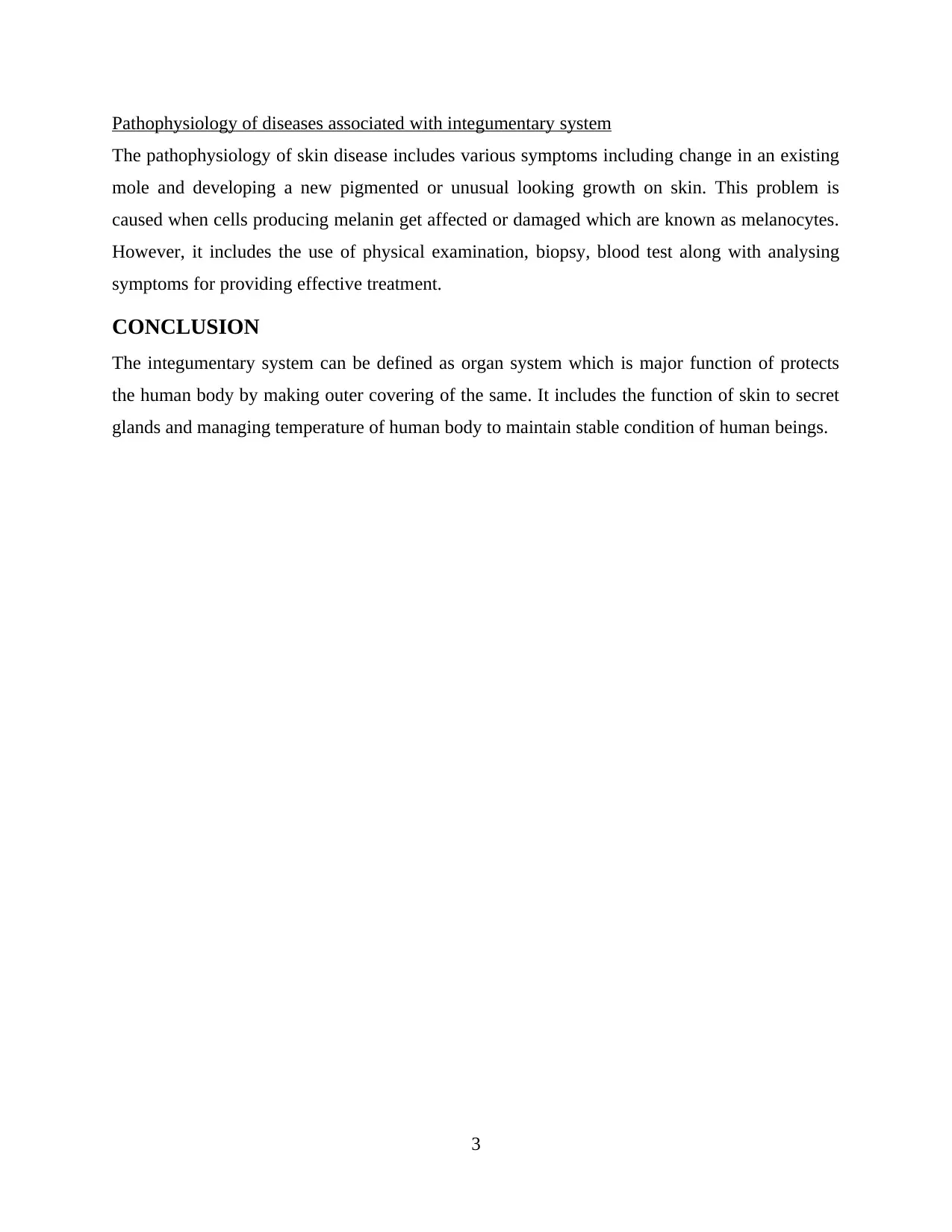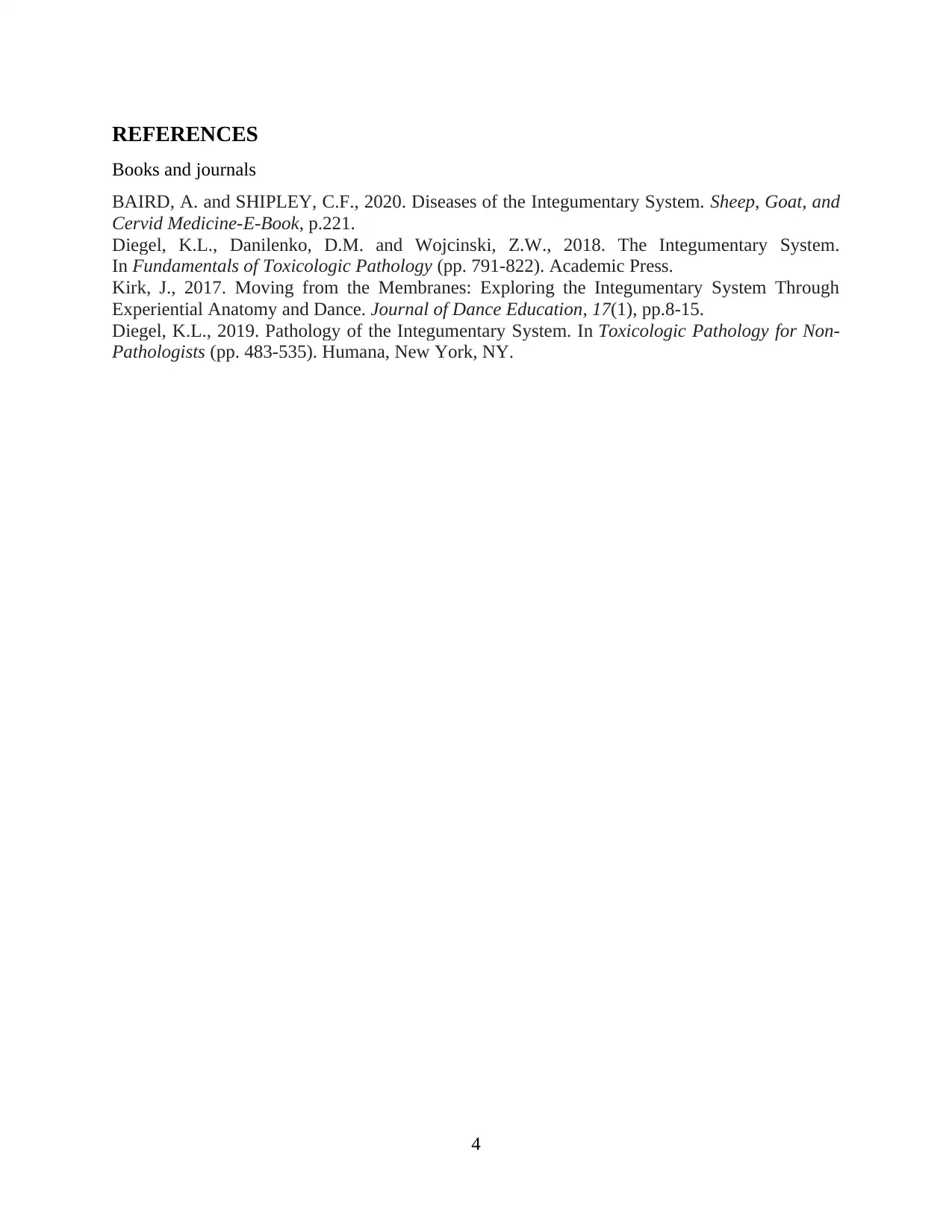Project 2: Analysis of the Integumentary System in Paramedical Science
VerifiedAdded on 2023/01/09
|7
|1092
|41
Project
AI Summary
This project on the integumentary system provides a comprehensive overview of its structure, physiology, and functions. It explores how the system matures with age, from birth to geriatric stages, and examines the roles of skin, nails, hair, and exocrine glands. The project delves into the physiology of skin color, hair growth, and nail growth, as well as the various layers of the skin, including the epidermis and dermis. It also discusses the normal functions of the integumentary system, such as protection, temperature regulation, elimination, and sensation. Furthermore, the project identifies common disorders like basal cell carcinoma, squamous cell carcinoma, melanoma, eczema, and acne, and it explains the pathophysiology of diseases associated with the integumentary system, including changes in moles and new growths. The project concludes by highlighting the system's crucial role in protecting the body and maintaining its overall health.

Paramedical Science
(Project 2)
(Project 2)
Paraphrase This Document
Need a fresh take? Get an instant paraphrase of this document with our AI Paraphraser

Table of Contents
INTRODUCTION...........................................................................................................................1
TASK...............................................................................................................................................1
Maturation – how does age affect the system, birth to geriatric?...........................................1
Physiology..............................................................................................................................1
Structure.................................................................................................................................1
Normal function......................................................................................................................2
Common disorders..................................................................................................................2
Pathophysiology of diseases associated with integumentary system.....................................2
CONCLUSION................................................................................................................................3
REFERENCES................................................................................................................................4
INTRODUCTION...........................................................................................................................1
TASK...............................................................................................................................................1
Maturation – how does age affect the system, birth to geriatric?...........................................1
Physiology..............................................................................................................................1
Structure.................................................................................................................................1
Normal function......................................................................................................................2
Common disorders..................................................................................................................2
Pathophysiology of diseases associated with integumentary system.....................................2
CONCLUSION................................................................................................................................3
REFERENCES................................................................................................................................4

⊘ This is a preview!⊘
Do you want full access?
Subscribe today to unlock all pages.

Trusted by 1+ million students worldwide

INTRODUCTION
Integumentary system refers to a kind of organ system containing several important parts and
glands to play function of the same. Basically, it is responsible for containing nails, skin, hair and
exocrine glands. However, they have their specific role to make entire functioning of
integumentary system possible in effective manner (BAIRD and SHIPLEY, 2020). This project
will focus on physiology and structure of integumentary system along with its functions. It will
also include common relevant disorders and pathophysiology of diseases related to
integumentary system.
TASK
Maturation – how does age affect the system, birth to geriatric?
The integumentary system is responsible for providing external or outer covering to the entire
human body. It has number of parts which plays an important role for providing an effective
body covering among human beings. Meanwhile, it is observed that integumentary system
involves skin, nails, hairs and exocrine glands for outer covering of human body. It is observed
that children and adults have strong skin cells which cannot be easily damaged. However, t has
been analysed that when a person enter in old age then the skin cells started weaken which can
be easily damaged. Moreover, the integumentary system has been developed from all three
embryonic layers such as ectoderm, mesoderm and endoderm.
Physiology
The physiology of integumentary system involves the number of normal process which is given
here. It includes the development of skin colour due to several elements such as melanin,
carotene, haemoglobin, emotions, redness or erythema, pallor or blanching, jaundice or a tallow
cast and bruises or block & blue marks on body (Diegel, Danilenko and Wojcinski, 2018).
However, it consist hair growth style including anagen which contributes to form and push the
club hair up the follicle. It includes the catagen when growth stops whereas telogen is resting
phase when hair follicle is completely at rest. Moreover, the nail growth is usually separate into
three parts such as germinal matrix, sterile matrix and dorsal roof of the nail fold respectively.
1
Integumentary system refers to a kind of organ system containing several important parts and
glands to play function of the same. Basically, it is responsible for containing nails, skin, hair and
exocrine glands. However, they have their specific role to make entire functioning of
integumentary system possible in effective manner (BAIRD and SHIPLEY, 2020). This project
will focus on physiology and structure of integumentary system along with its functions. It will
also include common relevant disorders and pathophysiology of diseases related to
integumentary system.
TASK
Maturation – how does age affect the system, birth to geriatric?
The integumentary system is responsible for providing external or outer covering to the entire
human body. It has number of parts which plays an important role for providing an effective
body covering among human beings. Meanwhile, it is observed that integumentary system
involves skin, nails, hairs and exocrine glands for outer covering of human body. It is observed
that children and adults have strong skin cells which cannot be easily damaged. However, t has
been analysed that when a person enter in old age then the skin cells started weaken which can
be easily damaged. Moreover, the integumentary system has been developed from all three
embryonic layers such as ectoderm, mesoderm and endoderm.
Physiology
The physiology of integumentary system involves the number of normal process which is given
here. It includes the development of skin colour due to several elements such as melanin,
carotene, haemoglobin, emotions, redness or erythema, pallor or blanching, jaundice or a tallow
cast and bruises or block & blue marks on body (Diegel, Danilenko and Wojcinski, 2018).
However, it consist hair growth style including anagen which contributes to form and push the
club hair up the follicle. It includes the catagen when growth stops whereas telogen is resting
phase when hair follicle is completely at rest. Moreover, the nail growth is usually separate into
three parts such as germinal matrix, sterile matrix and dorsal roof of the nail fold respectively.
1
Paraphrase This Document
Need a fresh take? Get an instant paraphrase of this document with our AI Paraphraser

Structure
The main part of integumentary system is known as skin and its associated parts which help to
protect human body. It includes multiple skin layers of cells and underlined structure of
connective tissue. However, it is observed that skin has deeper layer which has numerous blood
vessels due to which it considered as well vascularized part of it. It has some of autonomic,
sympathetic and sensory nerve fibres which play an important role to communicate from and to
the brain respectively (Kirk, 2017). Meanwhile, it is observed that skin has several layers such as
epidermis with stratum basale, stratum spinosum, stratum granulosum, stratum lucidum and
stratum corneum. It also contains dermis, hypodermis having sub parts like papillary layer and
reticular layer along with hypodermis and pigmentation
Normal function
There are number of functions that are played by integumentary system for maintaining
appropriate condition of human body. It includes the function of maintaining protection which
consist that secure deeper tissues from several kinds of damage like mechanical, chemicals, UV
radiation, bacterial, and thermal and desiccation damage. However, it has another function of
regulation body temperature by aiding heat loss or heat retention which is controlled via nervous
system. It involves the elimination by secreting urea and uric acid with the help of perspiration
developed via sweat glands. Meanwhile, skin has function to synthesize vitamin in skin by
sunlight with the help of modified cholesterol. They have function of sensation due to sensory
receptors of several factors like distinguishing heat, cold, touch, pressure and pain.
Common disorders
The integumentary system has several common disorders which may occur among human beings
and they are usually related to skin. It includes skin problems such as basal cell carcinoma which
is responsible for affecting the stratum basale of epidermis which is a common type of skin
cancer. It may results into symptoms like uneven patch, bump, growth or scar on skin surface
sometimes (Diegel, 2019). However, it consist the another disorder of squamous cell carcinoma
which generally impact on keratinocytes as well as stratum spinosum. Moreover, it involves the
melanoma, and tow very common skin eczema and acne which is generally observed among
people.
2
The main part of integumentary system is known as skin and its associated parts which help to
protect human body. It includes multiple skin layers of cells and underlined structure of
connective tissue. However, it is observed that skin has deeper layer which has numerous blood
vessels due to which it considered as well vascularized part of it. It has some of autonomic,
sympathetic and sensory nerve fibres which play an important role to communicate from and to
the brain respectively (Kirk, 2017). Meanwhile, it is observed that skin has several layers such as
epidermis with stratum basale, stratum spinosum, stratum granulosum, stratum lucidum and
stratum corneum. It also contains dermis, hypodermis having sub parts like papillary layer and
reticular layer along with hypodermis and pigmentation
Normal function
There are number of functions that are played by integumentary system for maintaining
appropriate condition of human body. It includes the function of maintaining protection which
consist that secure deeper tissues from several kinds of damage like mechanical, chemicals, UV
radiation, bacterial, and thermal and desiccation damage. However, it has another function of
regulation body temperature by aiding heat loss or heat retention which is controlled via nervous
system. It involves the elimination by secreting urea and uric acid with the help of perspiration
developed via sweat glands. Meanwhile, skin has function to synthesize vitamin in skin by
sunlight with the help of modified cholesterol. They have function of sensation due to sensory
receptors of several factors like distinguishing heat, cold, touch, pressure and pain.
Common disorders
The integumentary system has several common disorders which may occur among human beings
and they are usually related to skin. It includes skin problems such as basal cell carcinoma which
is responsible for affecting the stratum basale of epidermis which is a common type of skin
cancer. It may results into symptoms like uneven patch, bump, growth or scar on skin surface
sometimes (Diegel, 2019). However, it consist the another disorder of squamous cell carcinoma
which generally impact on keratinocytes as well as stratum spinosum. Moreover, it involves the
melanoma, and tow very common skin eczema and acne which is generally observed among
people.
2

Pathophysiology of diseases associated with integumentary system
The pathophysiology of skin disease includes various symptoms including change in an existing
mole and developing a new pigmented or unusual looking growth on skin. This problem is
caused when cells producing melanin get affected or damaged which are known as melanocytes.
However, it includes the use of physical examination, biopsy, blood test along with analysing
symptoms for providing effective treatment.
CONCLUSION
The integumentary system can be defined as organ system which is major function of protects
the human body by making outer covering of the same. It includes the function of skin to secret
glands and managing temperature of human body to maintain stable condition of human beings.
3
The pathophysiology of skin disease includes various symptoms including change in an existing
mole and developing a new pigmented or unusual looking growth on skin. This problem is
caused when cells producing melanin get affected or damaged which are known as melanocytes.
However, it includes the use of physical examination, biopsy, blood test along with analysing
symptoms for providing effective treatment.
CONCLUSION
The integumentary system can be defined as organ system which is major function of protects
the human body by making outer covering of the same. It includes the function of skin to secret
glands and managing temperature of human body to maintain stable condition of human beings.
3
⊘ This is a preview!⊘
Do you want full access?
Subscribe today to unlock all pages.

Trusted by 1+ million students worldwide

REFERENCES
Books and journals
BAIRD, A. and SHIPLEY, C.F., 2020. Diseases of the Integumentary System. Sheep, Goat, and
Cervid Medicine-E-Book, p.221.
Diegel, K.L., Danilenko, D.M. and Wojcinski, Z.W., 2018. The Integumentary System.
In Fundamentals of Toxicologic Pathology (pp. 791-822). Academic Press.
Kirk, J., 2017. Moving from the Membranes: Exploring the Integumentary System Through
Experiential Anatomy and Dance. Journal of Dance Education, 17(1), pp.8-15.
Diegel, K.L., 2019. Pathology of the Integumentary System. In Toxicologic Pathology for Non-
Pathologists (pp. 483-535). Humana, New York, NY.
4
Books and journals
BAIRD, A. and SHIPLEY, C.F., 2020. Diseases of the Integumentary System. Sheep, Goat, and
Cervid Medicine-E-Book, p.221.
Diegel, K.L., Danilenko, D.M. and Wojcinski, Z.W., 2018. The Integumentary System.
In Fundamentals of Toxicologic Pathology (pp. 791-822). Academic Press.
Kirk, J., 2017. Moving from the Membranes: Exploring the Integumentary System Through
Experiential Anatomy and Dance. Journal of Dance Education, 17(1), pp.8-15.
Diegel, K.L., 2019. Pathology of the Integumentary System. In Toxicologic Pathology for Non-
Pathologists (pp. 483-535). Humana, New York, NY.
4
1 out of 7
Related Documents
Your All-in-One AI-Powered Toolkit for Academic Success.
+13062052269
info@desklib.com
Available 24*7 on WhatsApp / Email
![[object Object]](/_next/static/media/star-bottom.7253800d.svg)
Unlock your academic potential
Copyright © 2020–2025 A2Z Services. All Rights Reserved. Developed and managed by ZUCOL.





